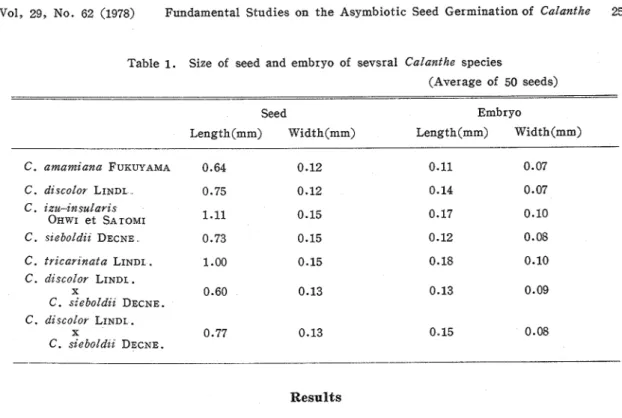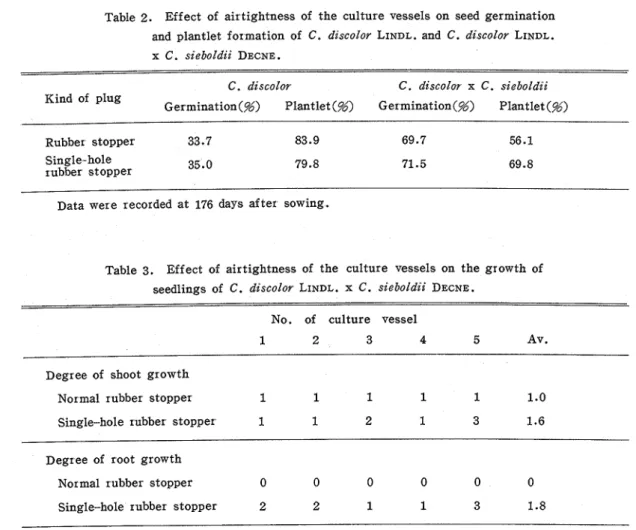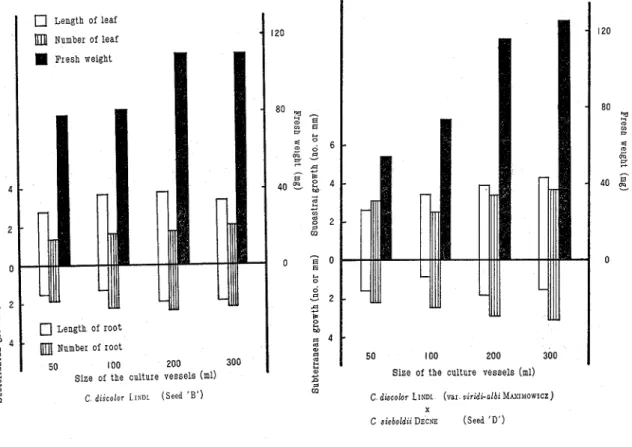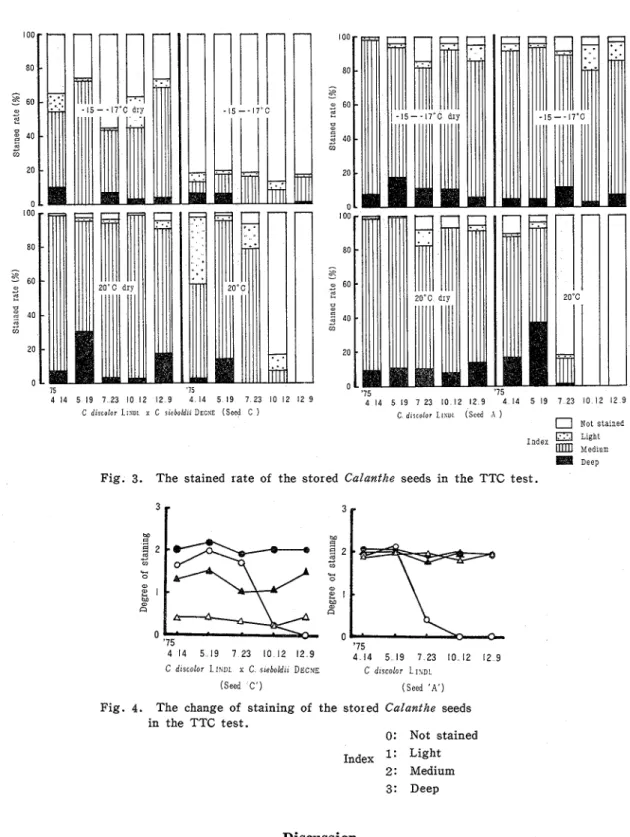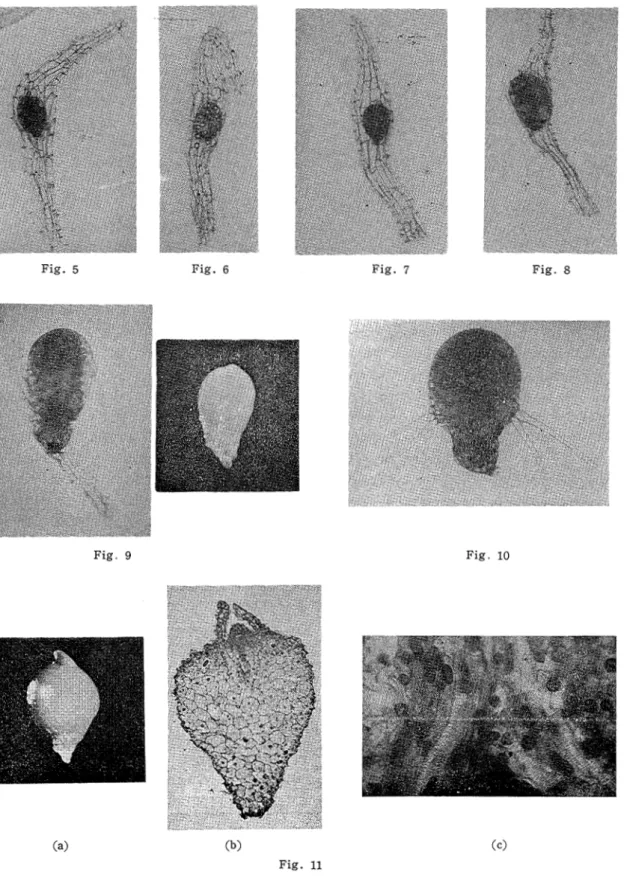Tech. Bull, Fac. Agr. Kagawa Univ. Vol. 29, No. 62, 251-259, 1978
FUNDAMENTAL STUDIES ON T H E ASYMBIOTIC
SEED GERMINATION OF CALANTHE
Atsushi HASEGAWA, Masanori GOI, Mami SATOand Yuzuru IHARA
Factors affecting the seed germination of Calanthe species were examined, using the seeds of Calanthe dzscolor EINQL. and C. dzscolor LINDL. x C. sieboldzz DECNE.
The airtightness of culture vessels had little effect on seed germination and plantlet forma- tion, but the growth of plantlet was better in the vessels with single-hole rubber stopper.
The size of vessels had no effects on the germination rate and number of days to germina- tion, but the growth of plantlet was better in large vessels than in small ones.
The germination rate was the highest when the seeds were sown immediately a f t e ~ harvest, and decreased as they were stored for 2 months or more longer. The lowering of germina- bility could be prevented to some extent by storage under dry conditions, independently of the storage temperatures.
The viability of seeds could be perceived by the 2,3,5-tr iphenyltetrazolium chloride (TTC) test.
z T j , (Calanthe dzscolor LINDL.) % d: U;z V$b X 3 z tr'j, (Calanthe szeboldzz DECNE.) 0
@q %HI,,
-r, zr
i t . m s ~ % % u c ~ g g ~ ~ a
E+L\<
9 f i 5 ~ ~ ~ ~ ~ 9 ~ \ - ~ & 2 4 L L .B % D % B ~ ~ & H % % ~ % I U ; ~ J B ~ K & % L ;Fa7b7 La:, Im@$?J0&RaB&d: 9 6 i B % @ ~ + <("kLk.
@#Dk$SHW??@%d:U;%??K%+6 H & K ~ ~ L T ~ # L L 7 a ; s ~ 7 L ~ ~ ,
Im@$?J04RK
L ; x f i a ; F a QD % @ @ S : ~
L. -&WKZ ~ ~ % L . B % B rftL+,Ez%s L L .93@kL@9j%$T@&2L9, figm?dfi%< k62!&TLk.
@ ~ @ $ E @ ~ O T E ~ T 6 ~ 2 I " c d : 9 , & ~ ? S B ~ . ; ~ @ F C D % ~ ~ & T % & ~ T ; ? L .
@ T D % ~ ~ % T T C E ~ K 1 9 &6?SLfZP%T;?k.
Introduction
Calanthe is a genus of 150 species of terrestrial orchids, extending from South Africa and Asia to the Pacific Islands; while only a species has been found in the West Indies and Central ~ m e r i c a ' ~ ' . In Japan, 17 or 19 species of Calanthe grow naturally, and we .Japanese have enjoyed the beautifulness and the variations in color and shape of these flowers from old times
252 Atsushi HASEGAWA, Masanori GOI, Mami SATO and Yuzuru IHARA Tech. Bull. Fac.. Agr.. Kagawa Univ..
(about the 15th century)" ' 4 ) . In recent years the culture of Calanthe comes into fashion. However there is undersupply for the demand of Calanthe seedlings because of the difficulty of the propagation by seeds and tissue culture. Nowadays, supply of the seedlings i s mostly owing to gathering of native one or dividing of cultivated one.
Present study was carried out in order to make clear some factors related to the asymbiotic seed ger mination of Calanthe.
Materials and Methods
The seed and embryo of Calanthe are very small (Table 1). The plant materials used a s seeds in this study are a s follows:
A C. discolor LINDL. Self pollinated '74. 4. 29 Harvested '74. 11. 6
B C. dzscolor LINDL. Self pollinated '74. 4. 29
Harvested '74. 11. 6 C C. discolor LINDL. x C. sieboldii DECNE.
Cross pollinated '74. 4. 24 Harvested '74. 11. 6
D C. discolor LINDL. (var. viridi-albi MAXIMOWICZ)
x
C. sieboldzz DECNE. Cross pollinated '74. 4. 24Harvested '74. 11. 6
After the pretreatment with 0.1M KOH for 10 min, the seeds were rinsed with about 1 litre of sterilized water, sterilized with the supernatant of calcium hypochlorite solution (5g of calcium hypochlorite per 250ml of sterilized water) for 3 min and sown on agar medium in the culture vessels. The medium contained the ingredients consisted of 3g Hyponex (7-6-19), 28 of Bacto-peptone, 35g of sucr ose and 15g of agar per litr e (H medium) (')
,
and according to circumstances 2g of activated charcoal was added (HA medium). The pH value of the media after autoclaving was around 5.0. The culture vessels were laid under 16 hour-light period illuminating with the plant grow lumps (about 400-500 lux) at 25OC.The 2,3,5-triphenyltetrazolium chloride (TTC) test was per formed for the germinability of
the seeds. About 180 seeds of each lot placed on the slide glass in a moisten Petri dish were incubated a t 2O0C for three days in a dark room. After the incubation, 0.1% solution of TTC was added to the seeds, and the Petri dishes were transferred t o the dark room at 30°C and kept for 24 hr.
Vol, 29, No. 62 (1978) Fundamental Studies on the Asymbiotic Seed Germination of Calanthe 253
Table 1. Size of seed and e m b ~ y o of sevsral Calanthe species
(Average of 50 seeds)
Seed Embryo
Length(mm) Width(mm) Length(mm) Width(mm)
C. amamzana FUKUYAMA 0.64 0.12 0.11 0.07 C . discolor LINDL 0.75 0.12 C . sieboldii DECNE 0.73 0.15 C . tricarinata LINDL. 1.00 0.15 0.18 0.10 C . dzscolor LINDL. x 0.60 0.13 0.13 0.09 C . sieboldiz DECNE. C . discolor LINDL. x 0.77 0.13 0.15 0.08 C . sieboldzz DECNE. Results
%.
Effect of airtightness of the culture vessels on the seed germination and the growth of seedlingsThe seeds 'A', 'C' and 'D' were sown in the vessels and plugged with two kinds of stop- pers, one of which was normal rubber stopper and the other was the single-hole rubber stopper stuffed with cotton. There was little difference in seed germination and plantlet for mation between the airtight and aerated vessels (Table 2). However, the growth of plantlet, especially roots, was better in the aerated vessels than the airtight (Table 3).
2.
Effect of the size of culture vessels on the growth of seedlingsThe seeds 'B' and 'D' were sown uniformly on HA medium. The size of vessels had no effect on the germination rate and number of days to germination. The growth of seedlings in 200 and 300ml vessels was superior to that in 50 and loom1 vessels. Similar tendency was shown for the fresh weight of seedlings (Fig. 1).
3.
Effect of storage conditions on the germination and the longevity of seedsThe seeds 'A' and 'C' were stored under the various conditions, i. e., (1) at 20°C, (2) at 20°C with dry condition, (3) at -15----17"C (in the freezer) and (4) at -15--17°C with dry condition.
The seeds were sown on HA medium in the test tube (20 x 200mm) at two months inter
-
vals. Percentage of the immatured seeds of 'A' and 'C' were about 20 and 5%, respectively. When the seeds were sown immediately after the harvest about 71.5% of the seed 'C' and 35% of the seed 'A' were germinated. The germination rate decreased gradually as the storage time was prolonged. The seed 'C' stored at 2O0C with dry conditions, however, showed a temporal rise of the germination rate after the storage for 6 to 8 months. The both seeds stored at 20°C did not germinate after the storage for 8 months (Fig. 2).254 Atsushi HASEGAWA, Masanori GOI, Mami SATO and Yuzuru IHARA Tech. Bull. Fac Agr. Kagawa Univ
The seeds stored a t 20°C with dry conditions for 13 months was stained a t high percentage by the TTC test, and the degree of staining was approximately the level 2 in the seed 'C' stored only a t 20°C with dry conditions and the seed 'A' stored at the three conditions except in the normal conditions at 20°C. The viability of the seeds stored at 20°C without dry con- dition was lost rapidly, and most of the seeds died within a year (Fig. 4).
Table 2. Effect of airtightness of the culture vessels on seed germination and plantlet formation of C. dzscolor LINDL. and C. discolor LINDL. x C . sieboldii DECNE.
C . discolor C . dzscolor x C . sieboldzi Kind of plug
Germination(%) Plantlet(%) Germination(%) Plantlet(%)
Rubber stopper 33.7 83.9 69.7 56.1
Single-hole 35.0 79.8 71.5 69.8
rubber stopper
Data were recorded at 176 days after sowing.
Table 3. Effect of airtightness of the culture vessels on the growth of seedlings of C. discolor LINDL. x C . sieboldzi DECNE.
No. of culture vessel
1 2 3 4 5 Av.
Degree of shoot growth
Normal rubber stopper 1 1 1 1 1 1.0
Single-hole rubber stopper 1 1 2 1 3 1.6
Degree of root growth
Nor ma1 rubber stopper 0 0 0 0 0 0
Single-hole rubber stopper 2 2 1 1 3 1.8
Degree of shoot and root growth were represented by index a s follows:
0: No growth 1: Poor 2 : Good 3: Excellent Data were recorded a t 84 days after sowing.
Vol. 29, No, 62 (1978) Fundamental Studies on the Asymbiotic Seed Germination of Calanthe 255 Length of leaf Number of leaf F r e s h weight
n
Length of root Number of loot 50 100 200Size of the culture vessels
-
sm c drscoiov L I ~ D I (Seed ' B ' )
5 0 100 200 300
Size of t h e culture vessels (ml)
I
9m
C discolor LINDL (val v i r i d b a l b i MAXIMOWICZ)
X
C sieboldii DECNE (Seed 'D')
Fig. 1. Effect of the size of culture vessels on the growth of Calanthe seedlings. Data were recorded a t 175 days after sowing.
100
-
a Contxol 0-0 20°C 80 . W 20°C. dry ,... &-A - 1 5 - - 1 7 ' C X-
-
- 1 5 - - 1 7 ' C d ~ y 2 6 0 . m, 0 2 .42
4 0 . ir $Sowing date Sowing date
C drscolor LISDI x C sicboldii DECSE (Seed ' C ) C discolor LISIN (Seed ' A )
Fig. 2. Effect of storage conditions on the seed germination of Calanthe. Data were recorded a t 200 days after sowing.
256 Atsushi HASEGAWA, Masanori GOI, Mami SATO and Yuzusu IHARA Tech.. Bull. Fac.. Agr. Kagawa Univ
4
14 5 19 7 23 10 12 12 9 4 14 5 19 7 23 10 12 12 9 C discolor LIBDL Y C iieboldii DECXE (Seed C )Fig. 3. The stained rate of the sto
C drrrolor L I W L (Seed 4 )
0
Not stained Index laLightmm
Medium Deep,red Calanthe seeds in the TTC test.
3 3
z
M9
2 d Qg
2 (0 .d Y) C u 0E
1 a, 3 2 1 n n 3 0 0 '75 4 14 5 19 7 23 10 12 12 9 4 14 5 19 7 23 10 12 12 9C drrcolor L I ~ D L x C r t e b o l d ~ ~ DECVE C discolor L I L D L
(Seed C ' ) (Seed ' A ' )
Fig. 4. The change of staining of the stored Calanthe seeds in the TTC test. 0: Not stained Index 1: Light 2: Medium 3: Deep Discussion
In general, asymbiotic seed germination of Calanthe i s difficult a s in the case of other
Vol. 29, No. 62 (1978) Fundamental Studies on the Asymbiotic Seed Germination of Calanthe 257
stances surrounding the seeds. The seeds of C. dzscolor LINRL. and C. tricarznata LINDL. will not germinate by any procedure tried so f a r , but those of C. sieboldii DECNE., C. bicolo~ LINDL. and C. f u r c a t a BATEMAN germinate easily, i. e., about 0.1%, in some case a s high a s 30% of these seeds may germinate'2'. The germination rate, however, may differ in compliance with crossing and clone or individuals in the same species,
In this study, the seeds of C. dzscolor and C. dzscolor
x
C. szeboldii were germinated easily, particularly when the seeds were sown immediately after the harvest (Fig. 2). The germi- nability of the seeds, however,
decreased gradually, depending upon the storage conditions with the lapse of storage time. The results of the TTC test was in accord, to some extent, with the germinability (Figs. 3 and 4). However, deep staining with the TTC test did not always correlated with germinability of C. dzscolor seeds (Figs. 2-4).
These results suggested that the requirements for seed germination differ among species, clone and even individuals.It is well known that the storage conditions affect the longevity of orchids seeds(385). In Calanthe the desirable storage condition has not been determined. The results obtained in this study suggest that the dry condition is favourable to the longevity of Calanthe seed, and that the seed can not maintain the germinability a t high level more than 12 months even if they are stored in such condition. The lower temperature about -15- -- 17OC did not preven- ted the seeds from the loosing of germinability. Ito reported that the pollen of C. f u r c a t a and Dendrobzum mbzle can be stored successfully for 2 years or more at ultra-cold temperature (-73°~)'1'. This methods may be applied to the Calanthe seeds. The reason why the ger
-
mination rate is r ised from 6 to 8 months in the seed 'C' particularly are remained unclear.The airtightness of the culture vessels had little effect on seed germination and plantlet for- mation, but affected badly for the growth of plantlet. This suggest that the plantlets demand much air supply for the growth. If the vessels were left in the airtightness, the plantlets will fade and die. It i s thus recommended that when the plantlets formed roots (Fig. 14), they should be transplanted to a new subculture medium in aerated vessels. In that case the plant- lets may grow into the good and strong seedlings with wide and thick leaves in dark green, providing good seedlings for potting. HA medium is recommended for the subculture medium because activated charcoal prevents the roots of plantlet from upwards apart from the medium (Fig. 15).
Literature Cited
( 1 ) ITO, I : Ultra-cold storage of orchid pollen,
Proc. 6 t h World Orchzd Conference, 143-148 (1971)
( 2 ) 110, I , KARASAWA, K.: CalanZhe spp. and its coterie, Seibundo, Tokyo (1969), (In Japanese).
( 3 ) KANO, K . : Studies on the media f o ~ orchid seed germination, Mem Fac A g r . Kagawa Unzv., (20), (1965).
( 4 ) KARASAWA, K , 110, I. : Calanthe spp
,
ColorBooks (349), Hoikusha, Osaka (1976), (In Japanese).
( 5 ) SIOUIAMIRE, W. : Terrestrial orchid seedl- ings. The or chids-Scientif ic studies (ed. WIIHNER, C. L.), 101-128, New York, John Wiley & Sons (1974).
( 6 ) TSUKAMOTO, Y, KANO, K
,
KATSUURA, T . :Instant media for orchid seed germination, Am. Orchzd Soc B u l l , 32, 354-355 (1963).
258 Atsushi HASEGAWA, Masanor i GOI, Mami SATO and Yuzuru IHARA Tech.. Bull.. Fac.. Agr. Kagawa Univ..
Fig. 5 Fig. 6 Fig. 7 Fig. 8
F i g . 9 Fig,. 10
(b)
Vol. 29, No. 62 (1978) Fundamental Studies on t h e Asymbiotic Seed Germination of Calanthe 259
F i g . 12 F i g . 13
F i g . 14 (a) (b)
F i g 15
F i g s 5-15 Stages in the germination of Calanthe seed and seedling development (5) Substantial seed, ( 6 ) Immatured (blasted) seed, ( 7 ) Seed slvollen and obvious suspensor, but still covered with testa, ( 8 ) Seed swollen more, ( 9 ) Embryo emarged from testa, (10) Embryo with five rhizoids, (11) Young protocorm (a) and longitudinal section (b) Vascular bundle was formed a t t h i s stage (c), (12 and 13) Young protocorms which external appearance changed from t h e spindle-shaped (see F i g 11-a) t o t h e swollen in t h e lower part-shaped, (14) Plantlet showing one root, (15) Subculture of seedlings: (a) H medium; t h e roots grown upwards, (b) HA medium; t h e roots submerged agar medium
